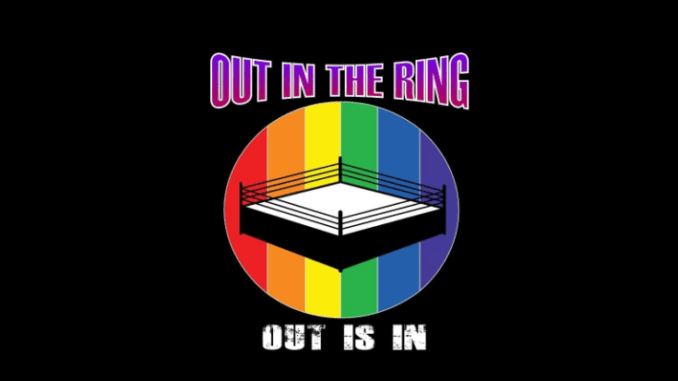
Since wrestling has been a thing, to some extent LGBTQ+ people have been involved in it. And a new documentary might open the eyes of viewers to how much this is the case.
“OUT IN THE RING,” a documentary produced by Ry Levey and Brad Webb, aims to provide a comprehensive history of both LGBTQ+ wrestlers and the existence of LGBTQ+ imagery and representation within numerous decades of professional wrestling. The roughly 100-minute doc is scheduled to make its TV premiere on November 15 next month, airing on Fuse and streaming on Fuse+.
The topics that the film aims to cover are quite broad, and successfully giving such a large scope of topics justice is certainly an ambitious move. The amount of ground the film had to cover meant that it takes sharp pivots and quickly zooms from one story to another throughout.
The first half of “OUT IN THE RING” takes a very historical approach to discussing LGBTQ+ wrestlers. Speaking to historians, reporters, and wrestlers, the tales of names like WWE Hall of Famer Pat Patterson, Jim Barnett, Chris Colt, and Sandy Parker were discussed. A large spotlight is put on Susan Green, who was interviewed for the documentary. Green debuted as a wrestler in the late 1960s under The Fabulous Moolah. She discussed performing as a closeted gay woman, and her experiences with other closeted wrestlers at the time like Parker and Patterson.
Later in the film, wrestlers like Parrow, Charlie Morgan, and Dani Jordyn were used as case studies about what it is like to be an out wrestler in more modern years. After the detailing of many wrestlers in previous decades being closeted and discriminated against for their sexuality, this part of the documentary was much more positive. In the case of Parrow, both he and his colleagues claimed that the quality of his performances as a wrestler improved once he was out in public.
“OUT IN THE RING” provides a critical analysis of notable moments in wrestling tied to LGBTQ+ wrestlers or characters that might challenge the viewers’ thoughts. The subject of having LGBTQ+ characters that are represented properly is addressed when discussing wrestlers like Adrian Adonis, Adrian Street, or Golddust, for example. Some in the film argued that these characters were a “double-edged sword,” in that they gave visibility to LGBTQ+ characters, but their use of LGBTQ+ visibility was a “shortcut” for viewers to rationalize hatred towards the characters.
Critical analysis continues when discussing more recent years for WWE. It is mentioned that while wrestler Fred Rosser (known at the time as Darren Young) was celebrated by the promotion for coming out as gay, he was rarely given any major opportunities during his run with the promotion, which wrapped up in 2017. The documentary also makes time to point out the irony in WWE presenting Finn Balor’s LGBTQ+ supportive Wrestlemania entrance the same year that the promotion signed a 10-year deal to host events in Saudi Arabia.
The wide-spanning amount of information that this documentary covers in roughly 100 minutes means that likely anyone who watches this will walk away with newfound information about either the history of LGBTQ+ wrestlers or the current representation.
If there is one thing that plays to the disadvantage of this documentary, it is the fact that it attempts to cover so much within less than two hours. There are points in the film where it feels like there is more space to delve into a topic — like the brief mention of the subtle romantic storytelling in the Golden Lovers duo of Kenny Omega and Kota Ibushi — but then a topic is only addressed at the surface level. The number of stories and wrestlers that this movie tries to cover might have oversaturated it at times but also proves that there is no shortage of valuable LGBTQ+ stories to tell within the wrestling space.
The movie’s attempt to inform you with as much information about LGBTQ+ wrestlers and themes in wrestling can feel a little overwhelming at times and cause the program to feel too jam-packed. A rewatch may be needed to fully digest all of the information that fits into this movie.
The documentary ends on an optimistic note, discussing how there currently are thriving spaces in wrestling where LGBTQ+ wrestlers are able to tell their stories in the ways they want to — a time period that wrestler Parrow called a “renaissance” for wrestling. Examples of this included Hoodslam, which is owned by trans wrestler Dark Sheik, and Pro Wrestling VIBE, which was known as “Butch vs. Gore” at the time of the documentary being shot and was owned by Billy Dixon. Comments from both Sheik and Dixon, along with Effy, who has run the “Big Gay Brunch” series of events under the GCW banner since 2020, are included in the documentary.
“OUT IN THE RING” grapples with wrestling’s messy past. It maintains a critical perspective of the treatment of LGBTQ+ people and characters within an art form that is homoerotic in nature.
Levey and Webb’s documentary manages to cover decades of LGBTQ+ wrestling history, both in and out of the ring, within two hours. The movie finds time to discuss topics like representation, intersectionality, and corporate activism, all while going over some of the most notable LGBTQ+ figures in wrestling history. If anything, the number of topics the movie tries to touch on shows that there is a massive need for more discussions and storytelling about LGBTQ+ wrestling and wrestlers and that this movie is a strong part of that discourse.
Out in the Ring will premiere on Fuse and Fuse+ in the U.S. beginning November 15.
Listen to director Ry Levey’s appearance on The Wellness Policy from June 2022.
